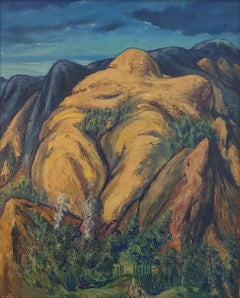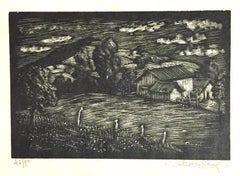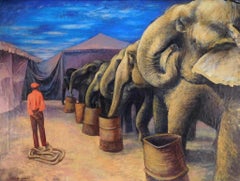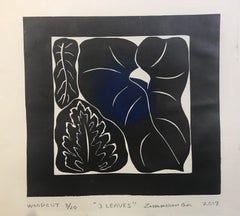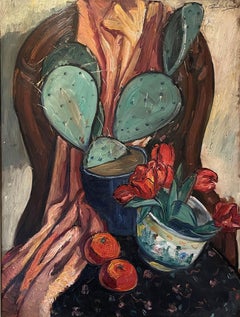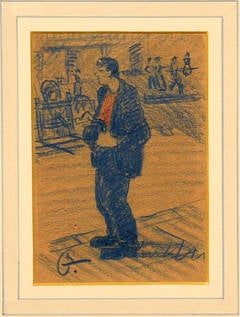Hendrik Glintenkamp Art
American, 1887-1946
The painter and illustrator Henry Glintenkamp (1887-1946) is known mainly for his anti-war illustrations that appeared in The Masses and other publications in the early twentieth century. As a painter, he was additionally successful, particularly in his landscape and urban scenes. Born in Augusta, New Jersey, the son of Hendrik and Sophie Dietz Glintenkamp, Henry received his elementary art training at the National Academy of Design (1903-06) before his study with Robert Henri the two years following.
Henri consequently attracted artists like Glintenkamp interested in returning to a sense of human qualities. Setting up his studio in the Lincoln Arcade Building with Stuart Davis and Glenn O. Coleman, Glintenkamp did work that reflects a preoccupation with urban scenes and landscapes.
In May of 1910 Glintenkamp exhibited his works as a student at the Henri School and at the Exhibition of Independent Artists of 1910. Two years later, he accepted the position of instructor at the Hoboken Arts Club in New Jersey and in 1913, he took up with others in the organization of The Masses, designed as a publication devoted to humanitarian causes. This publication stood in stark opposition to war, as its articles and cartoons reflected pacifism. At the Armory Show (1913), Glintenkamp exhibited The Village Cemetery. In 1917, Glintenkamp moved to Mexico to avoid the draft, and remained there until 1924, supporting "the socialist agenda of Mexico's new leadership."
The period following 1917 marks a new phase in the artist's development. Brighter in color and compositionally more involved, his later works are more discordant than the artist's earlier work. The artist sacrificed the atmospheric quality of the limited palette for the increased influence of modernist movements. After extensive travels in Europe, Glintenkamp returned to New York in 1934, and became a teacher at the New York School of Fine and Industrial Art and the John Reed Club School of Art. As chairman for the committee responsible for the organization of an Exhibition in Defense of World Democracy, in 1937, Glintenkamp continued his humanitarian purpose, though never really took up with the socialist rebels, many of whom followed similar groups and publications. Indeed, Glintenkamp was instrumental in founding the American Artists' Congress; he continued serving its needs as both the organization's president and secretary. A peripheral member of the impressionist-tonalist group in his early career, Glintenkamp had progressed through many American movements by the time of his death in 1946.to
1
2
2
1
1
1
1
"Mexican Mountains, " Hendrik Glintenkamp, Modernist Landscape
By Hendrik Glintenkamp
Located in New York, NY
Hendrik (Henry) J Glintenkamp (1887 - 1946)
Mexican Mountains, 1940
Oil on canvas
32 x 26 inches
Signed lower left; signed and dated on the reverse
T...
Category
1940s American Modern Hendrik Glintenkamp Art
Materials
Canvas, Oil
$7,800 Sale Price
20% Off
Hendrik Glintenkamp, (Farmyard)
By Hendrik Glintenkamp
Located in New York, NY
More a wood engraving rather than a woodcut, Glintenkamp's Farmyard scene was given all the care and detail of the artist's more complex images. It is signed and numbered in pencil. ...
Category
1920s American Modern Hendrik Glintenkamp Art
Materials
Woodcut
Related Items
Circus Elephants American Modernism WPA Regionalism Mid-Century Modern Oil
Located in New York, NY
Circus Elephants American Modernism WPA Regionalism Mid-Century Modern Oil. Signed lower left.
Not much is known about Marco de Marco, but just look at...
Category
1930s American Modern Hendrik Glintenkamp Art
Materials
Canvas, Oil
$6,900
H 32 in W 40 in D 3 in
Three leaves (taro) - Landscape Print - Woodcut Print By Marc Zimmerman
By Marc Zimmerman
Located in Carmel, CA
Minimal image in black ink on buff rice paper. Taro leaves are a simple form inspiring this woodcut print.
Three leaves (taro) - Landscape Print - Woodcut Print By Marc Zimmerman
T...
Category
2010s American Modern Hendrik Glintenkamp Art
Materials
Woodcut
WPA Landscape American Scene Social Realism Mid 20th Century Modern Farm Rural
By James McCracken
Located in New York, NY
WPA Landscape American Scene Social Realism Mid 20th Century Modern Farm Rural
James McCracken (1875 – 1967)
WPA Landscape
28 x 36 inches
Oil on canvas, c. 1930s
Signed lower right
...
Category
1930s American Modern Hendrik Glintenkamp Art
Materials
Canvas, Oil
NYC Cityscape American Scene WPA Modern Realism Mid 20th Century Architectural
By Ernest Fiene
Located in New York, NY
NYC Cityscape American Scene WPA Modern Realism Mid 20th Century Architectural
Ernest Fiene (1894-1965)
Cityscape
36 x 30 inches
Oil on canvas
Signed and dated 1930. lower right
Provenance
Estate of the artist.
ACA Galleries, New York
Exhibited
New York, Frank Rehn Gallery, Changing Old New York, 1931.
New York, ACA Galleries, Ernest Fiene: Art of the City, 1925-1955, May 2-23, 1981, n.p., no. 5.
BIO
Ernest Fiene was born in Elberfeld, Germany in 1894. As a teenager, Fiene immigrated to the United States in 1912. He studied art at the National Academy of Design in New York City from 1914 to 1918, taking day classes with Thomas Maynard and evening classes with Leon Kroll. Fiene continued his studies at the Beaux-Arts Institute of Design in New York from 1916 to 1918, adding classes in printmaking at the Art Students League in 1923.
Fiene began his career as an artist in 1919 with his first exhibition of watercolors at the MacDowell Club arranged by his mentor Robert Henri. In 1923 the Whitney Studio Club mounted a large exhibition of his works. The following year he had an exhibition at the New Gallery in New York, which completely sold out all fifty-two works, including paintings, watercolors, drawings, and etchings. With the proceeds of sales from the New Gallery exhibition, Ernest Fiene and his younger brother Paul, a sculptor, built studios in Woodstock, New York in 1925.
In the early Twenties Ernest Fiene painted mostly landscapes of Woodstock and both the Ramapo and Hudson River Valleys. The first monograph from the Younger Artists Series was published on Fiene in 1922. Published in Woodstock, the series went on to include Alexander Brook, Peggy Bacon, and Yasuo Kuniyoshi. The book reproduced 1 illustration in color and another 27 reproductions in black and white. Around 1925 Fiene became fascinated with the intensity, excitement, and opportunities for color harmonies New York City offered as a subject. His paintings shifted to urban and industrial themes with architecture, industry, and transportation becoming his subjects.
By 1926 Fiene had attracted the dealer Frank K.M. Rehn, who gave him a one-man exhibition that year, which travelled to the Boston Arts Club. C.W. Kraushaar Galleries gave Fiene a one-man exhibition of urban, landscape, portrait, and still life paintings in 1927. Julianna Force, the director of the Whitney Studio Club and first director of the Whitney Museum of American Art, included two of Fiene’s paintings in a fall exhibition in 1928. The Whitney Studio Club showed Fiene’s paintings in a two-man exhibition with Glenn O. Coleman that year and acquired three of Fiene’s paintings. Also in 1928 Fiene became affiliated with Edith Halpert’s Downtown Gallery where he had an exhibition of 20 lithographs in the spring. Fiene sold his house in Woodstock in 1928 to spend more of his time in New York City.
With so many successful exhibitions, Fiene returned to Paris in 1928-29 where he rented Jules Pascin's studio and studied at the Académie de la Grande Chaumière. In France, Fiene painted both landscape and urban subjects developed from ideas influenced by Cubist geometry and the use of flat areas of broad color. Upon returning to New York in 1930, Fiene used this new approach to continue to paint New York skyscraper and waterfront subjects, as well as to begin a series of paintings on changing old New York based on the excavations for Radio City Music Hall and the construction of the Empire State Building. Frank K.M. Rehn Galleries exhibited this series, titled “Changing Old New York,” in 1931. Fiene also has solo exhibitions at Rehn Galleries in 1930 and 1932. Fiene’s oil paintings are exhibited at the Chicago Arts Club in 1930 as well.
Fiene was included in the Museum of Modern Art’s exhibition Painting and Sculpture by Living Americans in December of 1931. Visiting New York, Henri Matisse saw the exhibition and called Fiene’s Razing Buildings, West 49th Street the finest painting he had seen in New York. Fiene had two mural studies from his Mechanical Progress series exhibited at the Museum of Modern Art’s exhibition Murals by American Painters and Photographers in 1932. Fiene sent View from my Window which depicts Fiene working on a lithograph stone while looking out his window to the newly completed Empire State Building to the Carnegie International in 1931. In 1932 Fiene participated in the first Biennial of American Painting at the Whitney Museum and his prints were included in exhibitions at the Downtown Gallery and the Wehye Gallery. In the same year, Fiene was awarded a Guggenheim fellowship to further study mural painting in Florence, Italy.
On his return from Italy in 1933 Fiene re-engaged himself in New York City life and won several public and private mural projects. Fiene resumed his active exhibition schedule, participating in two group exhibitions at the Whitney Museum and a one-man exhibition of recent paintings at the Downtown Gallery in January 1934. In 1933 he purchased a farm in Southbury, Connecticut, which added Connecticut scenes to his landscape subjects. This was also the year Fiene began to spend summers on Monhegan Island, Maine, where he painted seascapes, harbor scenes, and still lifes.
Fiene’s landscape paintings attracted numerous commissions as part of the American Scene movement. Through the fall and winter of 1935-36, Fiene took an extended sketching trip through the urban, industrial, and farming areas of Pennsylvania and West Virginia. Most of the twenty-four Pennsylvania urban and rural paintings...
Category
1930s American Modern Hendrik Glintenkamp Art
Materials
Canvas, Oil
Till the Clouds Roll By 1945 Frank Sinatra Mid Century Modern Hollywood Film WPA
By Richard Whorf
Located in New York, NY
Till the Clouds Roll By 1945 Frank Sinatra Mid Century Modern Hollywood Film WPA
TILL THE COULDS ROLL BY (Film Set), oil on canvas, 20 x 24 inches signed “Richard Whorf” lower right and signed and dated on the verso “R. Whorf/ Dec. 21, 1945. Frame by Hendenryk.
ABOUT THE PAINTING
This painting is from the collection of Barbara and Frank Sinatra, dated December 21, 1945 (just nine days after Frank Sinatra’s 30th birthday), and depicts the Metro-Goldwyn-Mayer Culver City backlot during the filming of Till the Clouds Roll By, the direction of the film having been taking over by Richard Whorf in December 1945. It is not presently clear if Whorf gave the Sinatras this painting as a gift, as the presence of the Dalzell Hatfield Galleries label on the verso indicates the painting may have been sourced there. Frank and Nancy Sinatra acquired a number of works from Dalzell Hatfield Galleries during the 1940’s, or perhaps they framed it for the couple.
Sinatra performed “Old Man River’ in the film. Sinatra and June Allyson are depicted in the center of the painting.
PROVENANCE From the Estate of Mrs. Nancy Sinatra; Dalzell Hatfield Galleries, Ambassador Hotel, Los Angeles.
An image of the Dalzell Hatfield label and the back of the original frame (which we replaced with a stunning Heydenrk frame) are attached.
Nancy Sinatra was Fran's first wife. Nancy Rose Barbato was 17 years old when she met Frank Sinatra, an 18-year-old singer from Hoboken, on the Jersey Shore in the summer of 1934. They married in 1939 at Our Lady of Sorrows Church in Jersey City where Frank gave Nancy a recording of a song dedicated to her titled "Our Love" as a wedding present. The young newlyweds lived and worked in New Jersey, where Frank worked as an unknown singing waiter and master of ceremonies at the Rustic Cabin while Nancy worked as a secretary at the American Type Founders.
His musical career took off after singing with big band leaders Harry James and Tommy Dorsey...
Category
1940s American Modern Hendrik Glintenkamp Art
Materials
Canvas, Oil
$75,000
H 31 in W 27 in D 2 in
Buffalo, NY Steel Mill American Scene Modernism WPA Era Industrial 20th Century
Located in New York, NY
Buffalo, NY Steel Mill American Scene Modernism WPA Era Industrial 20th Century
Ruth A. Haven Gay (1911-1992)
“Buffalo, NY Steel Mill”, c. 1935
23 x 28 inches
Oil on canvas
Signed G...
Category
1930s American Modern Hendrik Glintenkamp Art
Materials
Oil, Canvas
'Hill' — American Modernism, California
By Paul Landacre
Located in Myrtle Beach, SC
Paul Landacre, 'Hill', wood engraving, 1936, edition 60 (only 54 printed); only 2 impressions printed in a second edition of 150. Signed, titled, and numbered '49/60' in pencil. Wien...
Category
1930s American Modern Hendrik Glintenkamp Art
Materials
Woodcut
Desert Landscape with Smoke Trees
Located in San Francisco, CA
If you have lived in the American Southwest, you’ll recognize the distinctive colors and brilliant daylight depicted in this work by Western landscape painter Darwin Y. Taylor. The a...
Category
Mid-20th Century American Modern Hendrik Glintenkamp Art
Materials
Canvas, Oil
The Bridge
By Bror Julius Olsson Nordfeldt
Located in Santa Monica, CA
B. J. O. NORDFELDT (Bror Julius Olsson) 1878-1955)
THE BRIDGE, 1906
Color woodcut signed, dated 1906 and numbered 150 in pencil. Image 8 x 10 - small margins as issued. 4 corners tipped to acid free support board. Nordfelt is one of the most important early twentieth century American Masters of the Color woodcut. This 1906 work predates many of the other woodcut masters. Nordfeldt had a peculiar numbering system. The number is not necessarily the edition number.
Frances H. Gearhart, Blanche Lazzell, William S. Rice, Gustave Baumann, Margaret Patterson, Norma Basset Hall. Waldo Chase.
Category
Early 1900s American Modern Hendrik Glintenkamp Art
Materials
Woodcut
Original A Wonderful Opportunity for You, United States Navy 1917 vintage poster
Located in Spokane, WA
Original WW1 poster: A Wonderful Opportunity for You. Ashore, on leave. United States Navy. A pre-war recruiting lithographic poster features an ebullient sailor going home o...
Category
1910s American Modern Hendrik Glintenkamp Art
Materials
Lithograph
$1,575
H 28.25 in W 20.75 in D 0.05 in
THE THAW
By William Seltzer Rice
Located in Santa Monica, CA
WILLIAM SELTZER RICE (1873 - 1963)
THE THAW c 1915-20
Color woodcut, signed and titled in pencil. Image 8 7/8 x 12 inches, sheet 10 3/4 x 14 3/8 inches. On textured fibrous paper. V...
Category
1910s American Modern Hendrik Glintenkamp Art
Materials
Color, Woodcut
'Taos Placita' — American Southwest Regionalist Masterwork
By Gustave Baumann
Located in Myrtle Beach, SC
Gustave Baumann, 'Taos Placita', color woodcut, 1947, edition 125. Baumann 132. Signed, titled, and numbered '20-125' in pencil; with the artist’s Hand-in-Heart chop. A superb, richly-inked impression, with fresh colors, on fibrous oatmeal wove paper; the full sheet with margins (2 to 3 1/8 inches); slight rippling at the left sheet edge, in excellent condition. Matted to museum standards, unframed.
Image size 9 5/8 x 11 1/4 inches (244 x 286 mm); sheet size 13 1/4 x 17 inches (337 x 432 mm).
Collections: Harwood Museum of Art, New Mexico Museum of Art, Phoenix Art Museum, Scottsdale Art Museum, Wichita Art Museum.
ABOUT THE ARTIST
Gustave Baumann (1881-1971) was a renowned printmaker and a leading figure of the American color woodcut revival whose exquisite craftsmanship and vibrant imagery captured the essence of the Southwest.
"A brilliant printmaker, Baumann brought to the medium a full mastery of the craft of woodworking that he acquired from his father, a German cabinetmaker. This craftsmanship was coupled with a strong artistic training that resulted in the handsome objects we see in the exhibition today. After discovering New Mexico in 1918, Baumann began to explore in his woodblock prints of this period the light. color, and architectural forms of that landscape. His prints of this period are among the most beautiful and poetic images of the American West."
—Lewis I. Sharp, Director, Denver Art Museum
Baumann, the son of a craftsman, immigrated to the United States from Germany with his family when he was ten, settling in Chicago. From 1897 to 1904, he studied in the evenings at the Art Institute of Chicago, working in a commercial printmaking shop during the day. In 1905, he returned to Germany to attend the Kunstwerbe Schule in Munich, where he decided on a career in printmaking. He returned to Chicago in 1906 and worked for a few years as a graphic designer of labels.
Baumann made his first prints in 1909 and exhibited them at the Art Institute of Chicago the following year. In 1910, he moved to the artists’ colony in Nashville, Indiana, where he explored the creative and commercial possibilities of a career as a printmaker. In 1915, he exhibited his color woodcuts at the Panama-Pacific International Exposition in San Francisco, winning the gold medal.
Among Baumann’s ongoing commercial activities was his work for the Packard Motor Car Company from 1914 to 1920 where he produced designs, illustrations, and color woodcuts until 1923.
In 1919, Baumann’s printmaking work dominated the important exhibition of American color woodcuts at the Detroit Institute of Arts. Twenty-six of his prints were included, far more than the works of any other artist. A set of his blocks, a preparatory drawing, and seven progressive proofs complemented the exhibition. That same year, Baumann worked in New York and, over the summer, in Provincetown, Massachusetts. His airy images of Cape Cod employed soft, pastel colors and occasionally showed the influence of the white-line woodcut technique.
Many of his Chicago artist friends had traveled to the southwest, and Baumann became intrigued by their paintings, souvenirs, and stories of an exotic place named Taos, New Mexico. In the summer of 1918, he spent the summer in Taos sketching and painting before visiting Santa Fe. Paul Walter, the director of the Museum of New Mexico, offered him a studio in the museum's basement. Inspired by the rugged beauty of the Southwest—the vibrant colors and dramatic landscapes of the region became a central theme in his work, influencing his artistic style and subject matter for the remainder of his career. Later in the decade, he traveled to the West Coast and made prints of California landscape.
Baumann's prints became synonymous with the Southwest, capturing the spirit of its place in America's identity with a unique sense of authenticity and reverence. His iconic images of desert vistas, pueblo villages, and indigenous cultures served as visual tributes to the region's rich cultural heritage, earning him a dedicated following among collectors and curators alike.
A true craftsman and artist, Baumann completed every step of the printmaking process himself, cutting each block, mixing the inks, and printing every impression on the handmade paper he selected. His dedication to true craftsmanship and his commitment to preserving the integrity of his artistic vision earned him widespread acclaim and recognition within the art world. About the vibrant colors he produced, Baumann stated, “A knowledge of color needs to be acquired since they don’t all behave the same way when ground or mixed...careful chemistry goes into the making of colors, with meticulous testing for permanence. While complicated formulae evolve new colors, those derived from Earth and metal bases are still the most reliable.”
In the 1930s, Baumann became interested in puppet theater. He designed and carved his own marionettes and established a little traveling company. From 1943 to 1945, the artist carved an altarpiece for the Episcopal Church of the Holy Faith in Santa Fe. In 1952, a retrospective exhibition of his prints was mounted at the New Mexico Museum of Fine Arts. Throughout his prolific career, Baumann executed nearly four hundred color woodcuts.
Baumann’s woodcuts...
Category
1940s American Modern Hendrik Glintenkamp Art
Materials
Woodcut
$19,000
H 9.63 in W 11.25 in
Previously Available Items
"Cactus, Tulips, and Tangerines Still Life, " Hendrik Glintenkamp, Mexico Modern
By Hendrik Glintenkamp
Located in New York, NY
Hendrik (Henry) J Glintenkamp (1887 - 1946)
Cactus, Tulips, and Tangerines Still Life, 1928
Oil on board
26 x 20 inches
Signed upper right; signed, dated and titled on the reverse
T...
Category
1920s Hendrik Glintenkamp Art
Materials
Oil, Board
Streets of New York
By Hendrik Glintenkamp
Located in Wiscasset, ME
Born in 1887 in Augusta, New Jersey, painter, printmaker, illustrator and sculptor Hendrik Glintenkamp studied at the National Academy of Design and with Robert Henri and John Sloan ...
Category
1910s Ashcan School Hendrik Glintenkamp Art
Materials
Crayon
Hendrik Glintenkamp art for sale on 1stDibs.
Find a wide variety of authentic Hendrik Glintenkamp art available for sale on 1stDibs. You can also browse by medium to find art by Hendrik Glintenkamp in oil paint, paint, board and more. Much of the original work by this artist or collective was created during the 20th century and is mostly associated with the modern style. Not every interior allows for large Hendrik Glintenkamp art, so small editions measuring 6 inches across are available. Customers who are interested in this artist might also find the work of August Mosca, Luigi Lucioni, and Frank Weston Benson. Hendrik Glintenkamp art prices can differ depending upon medium, time period and other attributes. On 1stDibs, the price for these items starts at $400 and tops out at $9,750, while the average work can sell for $6,500.
